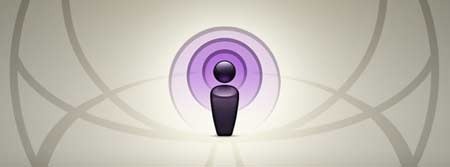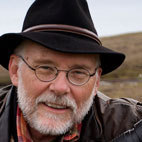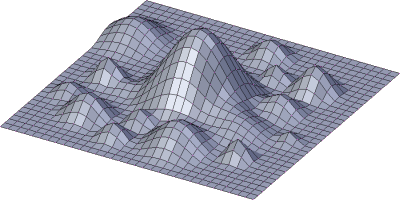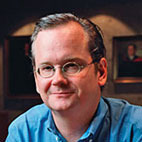Stewart Brand's Blog, page 93
February 3, 2012
A Short History of the Modern Calendar
Keeping time, it turns out, is a messy business. In order to satisfy science, religion, and sometimes ego, our calendar has changed quite a bit throughout history. This video by Jeremiah Warren tells the story up to now.
Since we can't predict what changes might be made in the future, the 10,000 Year Clock has been designed to keep track of the cycles of the Sun, the Moon, the planets and the constellations – things even the largest of egos will have trouble changing.

January 31, 2012
Long Now Media Update

WATCH
Lawrence Lessig's "How Money Corrupts Congress and a Plan to Stop It"
There is new media available from our monthly series, the Seminars About Long-term Thinking. Stewart Brand's summaries and audio downloads or podcasts of the talks are free to the public; Long Now members can view HD video of the Seminars and comment on them.

January 30, 2012
Long Quotes: Larry Lessig
"When you feel the impossibility of really thinking about the ten thousand year horizon, you've got to access that part in each of us which knows that the rational calculation is not the only reason we do things. We celebrate doing things that are plainly irrational—loving our children, loving our country, loving our planet—even though we'll never see any of those things come to the perfection we imagine."

January 27, 2012
Edge Question 02012
At the beginning of each year, John Brockman's Edge poses a question to a long list (192 this year!) of thinkers and authors. The ensuing onslaught of insight is then published for us all to enjoy. This year he asks:
What is your favorite deep, elegant, or beautiful explanation?
Scientists' greatest pleasure comes from theories that derive the solution to some deep puzzle from a small set of simple principles in a surprising way. These explanations are called "beautiful" or "elegant". Historical examples are Kepler's explanation of complex planetary motions as simple ellipses, Bohr's explanation of the periodic table of the elements in terms of electron shells, and Watson and Crick's double helix. Einstein famously said that he did not need experimental confirmation of his general theory of relativity because it "was so beautiful it had to be true."
The full list is bound to include a few folks you'd like to hear from. Below is the subset of respondents that have crossed through the Long Now orbit:
Board Members:
Stewart Brand discusses fitness landscapes.
David Eagleman tells us that the brain isn't an executive, but rather a team of rivals.
Brian Eno wraps the whole earth in a bow and plays John Conway's game of Life.
Kevin Kelly reminds us we're all star-stuff.
Paul Saffo digs into plate tectonics.
SALT Speakers:
Jared Diamond mixes equal parts sodium, potassium and squid, with electrifying results.
Freeman Dyson reconciles quantum mechanics & gravity. Or doesn't? It's kind of hard to tell.
George Dyson thinks it'll be a long time before we've got one good explanation for everything.
Juan Enriquez ruminates on what anthropomorphism illuminates and what it obscures.
Matt Ridley recalls Crick's metaphor of life as code.
Martin Rees warns of another Copernican demotion.
Clay Shirky takes us beyond memes.
Nassim Nicholas Taleb explains hormesis.
Carl Zimmer 's elegant explanation is his favorite because it is wrong.

January 24, 2012
Jim Richardson Ticket Info
The Long Now Foundation's monthly
Seminars About Long-term Thinking

Jim Richardson on "Heirlooms: Saving Humanity's 10,000 Year Legacy of Food"
TICKETS
Wednesday February 22, 02012 at 7:30pm Cowell Theater at Fort Mason
Long Now Members can reserve 2 seats, join today! • General Tickets $10
About this Seminar:
Agricultural biodiversity is as much in need of defending as the world's wildlife. Countless varieties of plants and animals were bred by the world's peoples for talents specific to every soil, climate, and human culture. Most of them have been lost—their hard-won genetic sophistication extinguished. But many have survived, thanks to professional and amateur devotion, and they are wondrous—living embodiments of humanity's deepest traditions.
Photojournalist Jim Richardson has been covering the agricultural beat for National Geographic since 1984. His spectacular photographs, and the stories he tells with them, are renowned.
Twitter - up to the minute info on tickets and events
Long Now Blog – daily updates on events and ideas
Facebook – stay in touch through our fan page
Long Now Meetups - join one or start your own

Envisioning the Future of Technology
Long Now Research Fellow Stuart Candy brought to our attention this visualization, which shows projections of what sorts of technologies will be available in the future, how soon, and how important they will be. It was created by London-based designer Michell Zappa, who leads a 'technological trend bureau' called Envisioning Technology. Their website explains that they seek to describe "where society is inexorably heading in the near future."
Our research facilitates understanding the field for those who work in technology by painting a bigger picture of where the landscape is heading. In this, we try guide both corporations and public institutions in making better decisions about their (and society's) future.

January 20, 2012
Long Now Media Update

LISTEN
(downloads tab)
Lawrence Lessig's "How Money Corrupts Congress and a Plan to Stop It"
There is new media available from our monthly series, the Seminars About Long-term Thinking. Stewart Brand's summaries and audio downloads or podcasts of the talks are free to the public; Long Now members can view HD video of the Seminars and comment on them.

January 19, 2012
Clock Project Update from Jeff Bezos
Below is the Clock Project update by Jeff Bezos published at http://www.10000yearclock.net
Quick Update and Video of the Raise Bore Milestone
We just completed the 12½ foot diameter, 500 foot deep vertical shaft for the 10,000 Year Clock. We used a mining technique called raise boring. Take a look at the video – it's an interesting operation. Instead of drilling down from the top, you pull a large diameter reamer up to the surface from the bottom using a smaller diameter pilot hole – more efficient than a top-down drill because the rubble isn't fighting gravity. It rains down beneath the advancing bore and gets hauled out a horizontal shaft at the bottom. Our next major step will be cutting the spiral stairway using a robotic stone cutting saw. In parallel, we're also manufacturing and testing the Clock components.
The Clock team continues to do an impressive and amazing job – they are organized and ingenious. Extra special thanks to Danny Hillis and Alexander Rose who deserve big kudos for driving to this key milestone. Big thanks as well to Swaggart Brothers, Cementation, and Geomagic, all of which played a crucial role. I encourage and invite you to become a member of The Long Now Foundation, the non-profit that was founded to foster long-term thinking and has focused tremendous energy on the Clock, as well as other noteworthy projects. You can visit their website to learn more and become a member.
Many thanks for your interest in the Clock and in the long view!
Jeff Bezos

Lawrence Lessig "How Money Corrupts Congress and a Plan to Stop It"
Public Funding for Public Elections
A Summary by Kevin Kelly
Larry Lessig gave a rousing performance for the 100th Seminar About Long-Term Thinking. In a lawyerly fashion he laid out evidence of a new type of corruption that is disrupting the American republic, and he offered a remedy for that corruption. Lessig has a very distinctive visual style of using slides that punctuates, word for word, the clear logic of his argument.
He said the type of corruption rampant in the US Congress is not the old type of bribery, where congressional representatives had safes in their offices to hold the cash they received for voting in certain directions. That is now illegal and eliminated. This new type of corruption is more subtle, indirect and harder to outlaw. Corporations legally donate money to the election campaigns of legislators, who in turn tend to vote in favor of the interests of those corporations. Non-profits like Maplight can graph the evidence that a representative voting in favor of a particular corporate-friendly law will receive 6 or 10 or 13 times the funding than someone who opposes the law. He cited studies that showed the ROI (return on investment) of lobbying to be 1,000%. It was one of the sanest expenses for a corporation. But the distortion is not just one sided. The issue that Congress spent the most time on in 2011 — a year when US was waging two wars, dealing with a near economic depression, and revamping health care — was the bank swipe fee. Who should pay the credit card use fee — the banks or the stores? There were corporations on both sides of this minor argument, but each side was promising campaign funds, so this was the issue that got all the attention of the officials. But the real money to be made in Congress is the relative fortune to be made as a lobbyist after leaving office. The differential in wages between a staff member and a lobbyist has escalated a hundred fold in the past 40 years. Now 43% of staff go on to become lobbyists. The promise of a well-paying job working for corporate interests later is enough to warp voting now.
None of this is illegal, but Lessig argues that we have a constitutional argument for eliminating it. The Constitution talks about the republic being "dependent on the people alone." But now it is dependent on corporate funders, and more and more JUST on corporate funders. His solution is to return the republic to being dependent on the people alone. His solution is an innovative kind of campaign finance reform. Give every voter a $50 campaign voucher. The $50 comes from the tax pool. It can be given to any candidate who accepts only money from the vouchers (and maybe a limit of an optional voluntary $100 per single voter). Thus all campaign money would come in very small amounts from The People. Lessig calculates that the total amount of money raised this public way would be 3 times the amount raised by private means in the last election cycles, and therefore more than adequate. But it would break the grip of corporate influence over what is voted up. The result would not be harmonious utopia, but the usual give-and-take compromises of politics — which the US has not seen in decades. The issues that people cared about would return to the agenda.
Lessig spent the remaining time and some of the question and answers talking about the real-politic necessary to pass this reform. A similar public financing scheme works in places like Sweden, where one elected legislator told Lessig he had never had to worry about where his funding came from. But the US has a fierce free-speech component not found elsewhere, and ironically, since spending money is viewed as a type of free speech, this complicates reform. As a free-speech advocate himself, and a constitutional lawyer, Lessig talked candidly about the difficulties of reform. He ended by saying that it would probably be a generational task. Overcoming institutional racism and sexism took more than one generation, and returning the republic to the "people alone" could take just as long, although in this case, the republic might not last that long without reform.
Audio of the talk will be posted on the Seminar page.

January 9, 2012
Scanning a 3,000-Year-Old Mummy
Presumably the programmers at Phillips weren't imagining this sort of patient.
Long Now Board Member David Eagleman recently had a very unusual visitor at his lab. At three thousand years of age, this is by far the oldest person Eagleman has ever put through a scanner. Neshkons is an Egyptian mummy, exhumed from Luxor in the 19th century and recently acquired by an acquaintance of Eagleman's. It turns out that scanning a mummy presents some interesting problems (and neuroscientific disappointments, such as having had his brain removed through his nostrils with a hook at death). Eagleman described the challenges in a blog post:
First, for those of you who know my lab, you'll know that we employ magnetic resonance imaging (MRI) when trying to decipher the human brain. So this was my first plan for the mummy. But there was a big concern here: the possibility that Neskhons had, enfolded in his ancient, never-unwrapped linens, a hunk of metal. That would spell bad news for the MRI, which is a giant magnet. [...]
And there was a second problem. MRI scanners work, in part, by detecting changes in electron spin in fluids in tissue and bone. Neskhons had no fluid at all.
In the end, Eagleman's team performed a CT scan, "a series of X-rays taken from all different angles and then reconstructed into a 3-dimensional whole." The results were fantastic, with high-resolution 3-dimensional images of a body still hidden inside its linen cocoon after three millennia. (Except for its head, which was laid bare at an "unwrapping party" in Cleveland in 1900.) The mummy is currently on display at the Museum of Fine Arts in Houston, Texas.
Neskhons' sarcophagus [...] is vividly painted with scenes about the afterlife. He presumably wouldn't have guessed that his body's afterlife would take place in a transparent case in a foreign land known as Houston, Texas, among tall and long-living people with magical tubes that have the power to peer into hidden dimensions of a body and reconstruct it at 1.5 millimeter resolution. For this reason and others, we treated the occasion with the respect and solemnity. After all, who knows where our bodies will end up in 3,000 years hence? Who will be looking at our empty hulls, and what technologies will they employ to reconstruct the details of our lives?







Stewart Brand's Blog
- Stewart Brand's profile
- 291 followers







